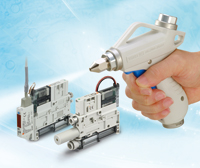
Posted to News on 20th Feb 2020, 00:00
The other side of the compressed air story
Views from Tony Baldwin CEMI, Energy and Resource Specialist, SMC Pneumatics.

Compressed air, whilst utilising a ‘free’ working fluid, is one of the highest energy consuming utilities found in today’s industrial premises. Having spent 30 years in the energy field reviewing many industrial applications, I have to admit the actual generation and distribution of compressed air has commonly been the first and prominent element of reviewing such systems. This has often been the extent of advice and recommendations to my clients.
More recently, I’ve been made aware of significant technology advances in the component compressed air reductions that are now available from manufacturers that can have significant impact to the use and costs attributable to this utility.
Vacuum Ejectors
Vacuum ejectors are prevalent in many factories for the movement for picking and placing of products whilst activities are carried out such as palletizers, jigs and component placement. The typical vacuum ejector uses compressed air through a venturi orifice to create the vacuum force. When the vacuum has been established the compressed air continues to pass the venturi in order to maintain the vacuum force.
Modern vacuum ejectors employ a sensing vacuum switch that isolates the compressed air line at the same time as a valve closes the vacuum line to the cup thereby stopping compressed air usage when the correct vacuum level is sensed. Should the vacuum pressure deteriorate (through porous material or worn or damaged vacuum cups), the solenoid switches the compressed air line back on to create further vacuum and then switch back off when vacuum pressure is re-established. Switching vacuum ejectors to the modern alternative can reduce compressed air usage by up to 90% over their predecessors.
Energy Saving Cylinders
Many pneumatic cylinders are provided with line pressure for both the power stroke and return stroke even though the return stroke may not be carrying a load or require the necessary force to return. Therefore the pressures for each stroke can be adjusted to provide compressed air savings that can be significant based for large bore, large volume displacements or high frequency operations. For example 5 bar may be required on the outward (power) stroke and a reduced 2 bar pressure for the return stroke may be acceptable. When the volume of the cylinder is such that the volume saved in compressed air can be considerable or the number of strokes per hour can lead to 20-30% reduction in air consumption.
Further to this, specific energy recovery cylinders that have the necessary integral porting, can utilise the air from the power stroke to offset air usage in the return stroke of a cylinder. By doing so up to 45% reduction of compressed air is possible compared to a standard cylinder.
Blow Guns
The ubiquitous blow gun can be found in the majority of factory compressed air systems, used for the clearing of swarf, debris and partials from working surfaces through to cleaning and blow out of cleaning fluids and oils and a multitude of other tasks. The air consumption of blow guns can become a significant element of the overall factory energy air consumption.
Modern blow guns are specifically designed to minimise the use of air during their operation. The use of high efficiency nozzles that entrain air through the use of the Bernoulli effect can reduce air consumption by 30% over the conventional gun whilst have the same effective out-put. Com-bined with correct fittings, connectors, and the selection of coiled tube can have a significant effect on air usage.
Air guns can easily be operated at or near factory line pressure with little disregard. A simple on/off type of blowgun should always be used with a tamper-proof pre-set regulator, set at 2 bar. This is a value which has been long recommended by the American OSHA body but does not negate the possibility of compressed air being injected through the skin.
Energy Saving Blow Guns
Energy saving blow guns are now being developed to prevent the continuous blowing of air. They utilise the integral reservoir of compressed air to permit the rapid fire impulse method to displace fragments and flakes of material.
Therefore the use of 3-4 sub second repeated air blasts can clear the equivalent material as a constant stream of compressed air at minimal consumption.
Whilst we have just looked at three simple areas of air usage reduction, development in a number of areas is ongoing; from low wattage solenoids on air manifolds through to pressure boosters for high pressure applications allowing lower factory line pressures to be set.
Development of energy efficient pneumatic components like those discussed above are helping end users to dramatically lower their air usage and therefore energy consumption.
There will always be the necessity to evaluate the generation and distribution of compressed air to ensure correct delivery of air is optimum and not wasted, but we must not forget the components that affect the direct use that have their role to play too.







